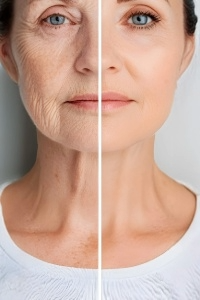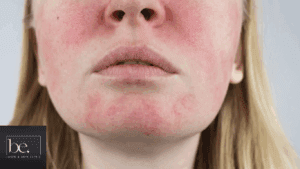Menopause can feel like a wild ride, and unexpected hair growth is part of the fun (not!). Menopause hormonal laser treatments can help keep those extra hairs in check. Here, I’ll share simple ways to tailor your sessions, line them up with your body’s ups and downs and why getting the right specialist on board matters.
Key Takeaways
- Get a personalised hormone check to shape your Menopause hormonal laser plan.
- Time your laser sessions to match your hormone swings for smoother results.
- Work with specialists, add skin checks and extra therapies for lasting hair control.
.
Tailoring Menopause Hormonal Laser Treatments

Laser hair removal during menopause? It’s not always a walk in the park. Those pesky hormonal changes can throw a spanner in the works, leading to regrowth even after treatment. But don’t worry, it’s totally manageable with the right approach. The key is to tailor the treatment to your specific needs.
Personalised Hormonal Profile Assessments
First things first, let’s get to know your hormones. A standard treatment just won’t cut it. We’re talking about getting a proper assessment of your hormonal profile. This usually involves blood tests to check your oestrogen, testosterone, and other hormone levels. Knowing where you stand helps us understand how your hair follicles are likely to react to the laser. It’s like having a map before you set off on a journey – you’re less likely to get lost!
Crafting A Bespoke Treatment Regimen
Once we’ve got your hormonal profile, it’s time to get personal. This isn’t a one-size-fits-all situation. We’ll use the information to create a treatment plan that’s just for you. This might mean adjusting the laser’s intensity, the number of sessions, or even the type of laser used. Think of it like getting a tailored suit – it’s made to fit you perfectly. We might also suggest combining laser hair removal treatments with other methods, like waxing, to tackle stubborn hairs.
It’s all about being proactive and understanding that menopause throws a curveball. By tailoring the treatment, we can increase your chances of success and keep those unwanted hairs at bay. It might take a bit more effort, but the results are worth it.
Here’s a quick look at what a tailored regimen might involve:
- Adjusting laser intensity based on skin type and hair colour.
- Scheduling more frequent sessions initially to combat hormonal regrowth.
- Using different laser types to target various hair thicknesses.
- Incorporating hormone level monitoring to adapt the plan as needed.
.
Synchronising Menopause Hormonal Laser Sessions With Body Rhythms

Right, so you’re thinking about laser hair removal during menopause? Smart move. But here’s the thing: it’s not just about zapping away the hair; it’s about timing it right. Menopause throws your hormones into a bit of a spin, and that can seriously affect how well the laser works. Think of it like this: you wouldn’t plant seeds in the middle of winter, would you? Same goes for laser hair removal – timing is everything.
Mapping Menopausal Hormone Fluctuations
First things first, you need to get to know your hormone cycle. It’s not as regular as it used to be, but there are still patterns. Tracking these fluctuations can help you schedule your laser sessions for when they’ll be most effective. It’s a bit like being a detective, but instead of solving a crime, you’re solving the mystery of your hair growth. Keep a diary, note down when you’re feeling particularly hairy (we’ve all been there), and see if you can spot any trends. This info is gold when you chat with your laser technician.
Adapting Interval Strategies
Okay, so you’ve got your hormone map. Now what? Well, it’s time to get flexible with your laser session intervals. The standard 4-6 weeks between sessions might not cut it during menopause. You might need to space them out more, or even bring them closer together, depending on what your hormones are up to. It’s all about being adaptable. Think of it as a dance – you’re moving with your body’s rhythm, not against it. And remember, laser hair removal treatments are more effective when you work with your body, not against it.
It’s important to remember that everyone’s menopause journey is different. What works for your mate might not work for you. Don’t be afraid to experiment and find what suits you best. And always, always listen to your body. It knows what it’s doing, even if it doesn’t always feel like it.
Here’s a rough guide, but remember, it’s just a starting point:
- High Oestrogen: Hair growth might be slower, so longer intervals could work.
- Low Oestrogen: Hair growth might be faster, so shorter intervals might be needed.
- Androgen Surge: Expect more hair growth; discuss with your technician.
.
Ultimately, it’s about finding what works for you. Don’t be afraid to ask questions, do your research, and be patient. You’ll get there in the end.
Collaborating With Specialists For Sustainable Menopause Hormonal Laser Results
Let’s be real, going it alone during menopause, especially when dealing with hormonal hair regrowth, can feel like navigating a minefield. That’s where bringing in the pros comes in. It’s not just about zapping away unwanted hair; it’s about understanding what’s going on beneath the surface and creating a plan that actually works long-term.
Comprehensive Hormone And Skin Evaluation
Think of this as your body’s health MOT. Before diving into any laser treatments, it’s worth getting a proper assessment. This usually involves:
- Checking your hormone levels to see exactly what’s fluctuating.
- Evaluating your skin type and sensitivity to ensure the laser settings are spot-on.
- Discussing your medical history and any medications you’re on, as these can impact treatment.
.
This thorough approach helps to avoid any nasty surprises down the line and ensures the laser treatment is tailored to your specific needs. It’s about being proactive, not reactive.
Integrating Complementary Therapies
Laser hair removal is great, but it’s not always a silver bullet. Sometimes, you need to bring in the big guns – or, in this case, other therapies. This could mean:
- Hormone Replacement Therapy (HRT): If your hormone levels are all over the place, HRT might help stabilise things and reduce hair regrowth. Always consult your GP for medical advice.
- Topical Treatments: Certain creams or lotions can slow down hair growth or reduce its thickness.
- Diet and Lifestyle Changes: Believe it or not, what you eat and how you live can impact your hormones. A balanced diet and regular exercise can make a difference.
.
Consider laser hair removal treatments as part of a bigger picture. By working with specialists, you’re not just getting rid of hair; you’re investing in your overall well-being and confidence.
Working with experts can help you get long-lasting results from hormonal laser during menopause. You can ask questions and make a plan that suits you. Ready to try it? Visit our website to book your consultation!
Conclusion
Honestly, laser hair removal won’t zap every last strand in one go, especially during menopause when your hormones are playing up. You’ll need a handful of sessions and, yes, some top-ups later on. If a stray hair pops up, don’t panic—it’s just your body doing its thing. The key is sticking to the plan you and your pro worked out and tweaking it if needed. Over time, you’ll see less regrowth and feel more at ease in your skin. So go on, book those follow-ups, and give yourself a pat on the back for taking charge.
See how we treat hormonal regrowth → Laser Hair Removal
Book your hormone-smart plan → Contact
Frequently Asked Questions
Does laser hair removal still work during menopause?
Yes, laser hair removal can work well when you’re in menopause. Your hormones might make some hairs grow back, so you may need more sessions than before. Stick to your plan and have a chat with your specialist if you spot new hairs popping up.
Will I need extra top-up sessions because of hormonal changes?
Most likely. Menopause can wake up old hair follicles, which means you might need a few maintenance treatments now and then. Your laser expert can help you pick the right timing to keep things smooth.
Are there any side effects I should look out for?
You might notice a bit of redness, mild swelling or a tingling feel right after treatment. It usually calms down in a few hours. Use cool packs and stick to your specialist’s after-care tips to stay comfy.




